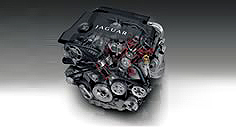To meet the needs of drivers around the world, our researchers are making diesel engines cleaner and more efficient while supporting the development of a cleaner diesel fuel infrastructure.

Renewed Interest in the U.S.
Despite their popularity in Europe, diesels for light-duty vehicles all but vanished in a cloud of black smoke in the 1980s in the United States. However, there's been a resurgence of interest in diesels in the United States recently. This interest has been primarily driven by the need for improved fuel economy, which diesels can deliver.
Benefits of Diesel
In addition to improved fuel economy, diesels offer other benefits. Compared to gasoline engines, diesel engines produce 20 to 30 percent less CO2 emissions, which contribute to climate change. And turbocharged diesel engines produce far more torque than gasoline engines, making them fun to drive and well-suited to tasks like towing.
To make diesels attractive to consumers, the Ford Research and Innovation Center is developing diesel engines that are as fuel efficient and fun to drive as ever, but also address customer concerns about excessive noise, smoke and odor. In addition, the diesel engines they're developing include new technologies to meet stringent new emissions regulations.
Cleaner Diesel Engines
To derive the greatest benefit from diesel fuel, we're using a common rail fuel injection system. This system stores fuel under high pressure in a central fuel rail and delivers it to electronically controlled fuel injectors. By storing the fuel under high pressure, precise quantities of fuel can be delivered to the engine at just the right time, so that the fuel burns more efficiently and cleaner. Improved efficiency results in improved mileage and engine performance, while minimizing noise.
Cleaner Diesel Emissions
Today's diesel engines are friendlier to the environment than ever before—the noise and smoke people associate with diesels are now a thing of the past. And diesels actually have a number of environmental advantages over gasoline-powered internal combustion engines: two of the four regulated emissions, hydrocarbons and carbon monoxide, are inherently low for diesel engines.
Our engineers have found ways to further reduce the other two emissions, particulate matter and nitrogen oxide.
Reducing Particulate Emissions
We developed the Diesel Particulate Filter (DPF) for our vehicles to trap carbon deposits as they exit the combustion system. As exhaust gas flows through the DPF, more than 90% of the particulate matter is trapped and kept from entering the air.
The DPF is available in new diesel vehicles produced for 2007 and beyond.
Reducing Nitrogen Oxide Emissions
To meet nitrogen oxide standards when they go into effect in 2010, we've improved combustion systems and developed the use of Exhaust Gas Recirculation (EGR).
In addition to developing the EGR system, we're also implementing the Selective Catalytic Reduction (SCR) method to reduce nitrogen oxide. SCR requires adding a reducing agent called AdBlue®. When AdBlue® is injected into the exhaust, ammonia is released, which reduces the nitrogen oxide. By carefully balancing the amount of AdBlue® injected, both the ammonia and the nitrogen oxide will be consumed over the SCR catalyst, reducing the vehicle's emissions.
Cleaner Diesel Fuel
Much like the transition from leaded to unleaded gasoline in the 1970s, the transition to cleaner diesel fuel has allowed significant improvement in exhaust emissions. The most promising cleaner diesel fuel is ultra-low sulfur diesel (ULSD) fuel, which can be used in any diesel engine.
ULSD has dramatically less sulfur content than regular diesel fuel. Less sulfur means less odor and fewer sulfate emissions. Most importantly, low-sulfur fuel enables the use of emissions reduction catalysts and the particulate filter, which can limit the emission of carbon monoxide, hydrocarbons, nitrogen oxides and particulate matter to nearly undetectable levels.
ULSD is currently available throughout the United States.

